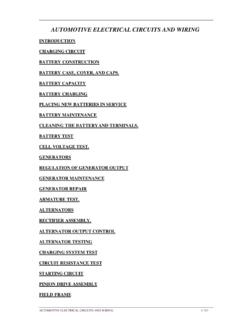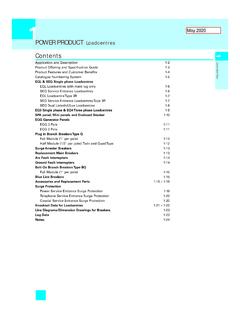Transcription of RECTIFIER SELECTION, OPERATION &MAINTENANCE
1 RECTIFIERSELECTION, OPERATION &MAINTENANCEP resented byMarty IozzoWhat Is A RECTIFIER and What Does It Do? It has been established that DC electricity will generate corrosion, and corrosion in turn will generate DC electricity. Therefore, it is possible to prevent corrosion by the use of DC electricity A Direct Current passing froma structure will cause corrosion, and a Direct Current impressed ontoa structure will stop corrosion The RECTIFIER is used to deliver or impress a Direct Current onto a structure The RECTIFIER has two functions:1. To transform incoming line voltage (AC) provided by the utility company to a usable voltage, and2.
2 To convert the usable AC voltage to Direct Current (DC) to be used for cathodic protectionWhen Selecting your Designed for rugged unattended service Cooling options Cabinet options Input AC Power Output DC Power keeping possible future requirements in mindWhat s the Perfect RECTIFIER for Me? Constant CurrentMaintains a constant current output by adjusting the voltage as site conditions fluctuate Auto PotentialAdjusts the RECTIFIER output to maintain a desired structure to soil potential Manual Tap (Constant Voltage)Set it and forget itUnpacking and Installing your RECTIFIER Check for freight damage Tighten all loose connections Select a location that s easilyaccessible Do not install near heat producing equipment Make sure the RECTIFIER is properly groundedProper Output Polarity Structure = Negative Anode = PositiveCP is a SNAP Common Causes of Cathodic Protection System Failures010203040506070 RectifierCablesGroundbedAC PowerAs with any electrical or mechanical device, RECTIFIER downtime will occur due to unplanned failure of the good maintenance program will help ward off some component failures.
3 And basic troubleshooting skills will bring the RECTIFIER back on Preventive Maintenance Checks And Services The RECTIFIER enclosure should be maintained Rectifiers must be allowed to cool properly RECTIFIER enclosure must be properly grounded Check all connections for tightness All RECTIFIER components should be kept clean Basic measurements should be recorded AC input voltage and amperage Stack AC input voltage DC output voltage and amperage Transformer tap settingsRectifier ComponentsTo best understand all components of the RECTIFIER and their relation to one another, the best place to start is at the input AC Input Input Lightning Arrestor Main Circuit Breaker Power Transformer RECTIFIER Stack Fuses or Secondary Breakers Meters Shunt Output Lightning Arrestor Filters AccessoriesLightning Arrestors Usually found on the input and output of the RECTIFIER Protects the RECTIFIER from extreme voltage surges Most configurations are a set of gapped points that an arc current can travel when a voltage surge is great enough in magnitudeMain Circuit Breaker Turns the incoming AC on or off Must be placed in each HOT supply line Provides overload protection to the
4 RECTIFIER Contains either a thermal or magnetic trip Or a combination of bothPower Transformer Converts the incoming AC voltage to a usable voltage Primary Input Secondary Output The secondary allows for adjustment of the RECTIFIER Most transformers used in rectifiers are step down or bucking RECTIFIER Stack Converts incoming AC to DC output It s function is to pass current in one direction and block it in the opposite direction Selenium SiliconRectifier Stack Silicon Cost effective Very efficient Does not age Longer life Much higher output rating Easily replaced Must be surge protected Will not show signs of visible damageRectifier Stack Selenium Can withstand Voltage surges Can withstand short term overload Becomes less efficient with age Becomes less efficient with heat More difficult to replace If it looks good, it s probably goodFuses & Secondary Breakers Protects the more expensive RECTIFIER components.
5 Output Meters Used in the RECTIFIER to indicate the amount of DC Voltage and/or current at the output Always carry a portable volt/amp meter when servicing the RECTIFIER , as RECTIFIER meters have been known to give erroneous readingsShunts Calibrated device (resistor) used in the DC Circuit for monitoring purposes. DC current can be calculated from the measured voltage drop across the shuntFilters & Accessories All RECTIFIER manufacturers offer various accessories to enhance their products Filters Lights Alarms AC outlets Hour meters Remote monitorsBefore We Start A Few PrecautionsBe Aware of High Voltages!
6 9 Backhand Rule: Touch the RECTIFIER enclosure with the back of your hand9De energize:If possible, disconnect the power at the source9 One Hand Rule:If possible, work within the enclosure with only one hand9 Look Away: When energizing the RECTIFIER , look away or cover your face9 Insulated Hand/Foot wear:Wear them to prevent electrocution9 Work In Pairs: For obvious reasons9 Weather:Do not attempt repairs during inclement weather9 Jewelry:Do not wear jewelry while working on live circuits9 Fatigue:Do not work on energized equipment while mentally or physically fatigued9 Maintain Constant Vigilance: Know where you are with respect to live circuits9 Working Knowledge: Have a general understanding of the RECTIFIER circuit OPERATION and basic troubleshooting skillsAnd Check For Nests And Other Critters!
7 Troubleshooting EquipmentDoesn t have to be elaborate only functionalProper tools will give the field technician the ability to make all repairs needed. Recommended tools and equipment might be: Digital voltmeter Amp clamp Heavy shorting cables Insulated jumper cables Spare calibrated shunt Load resistor Assorted small hand toolsTroubleshootingMost common RECTIFIER problems encountered are: No input or line voltage Blown fuses Faulty meters Loose or corroded terminals Open groundbed leads Lightning damageMost Problems Are ObviousSome Problems Are Really ObviousSome Problems Are Really, Really ObviousAnd Some Are Tough To FindTroubleshooting Tips Many RECTIFIER problems are obvious to the experienced technician upon physical examination.
8 Look for loose connections, signs of arcing, strange odors or discoloration. Carry an inventory of spare parts. The most common being: Breakers Fuses Diodes Bridge rectifiers Wire Miscellaneous connectors Control boards for auto controlled rectifiersMore Troubleshooting Tips No AC line voltage: Do not overlook the possibility that service to the RECTIFIER may have been interrupted. Defective Meters: Never trust the RECTIFIER meters. Always verify with a portable voltmeter known to be good. Breaker tripped or blown fuse: If the breaker trips repeatedly even with the output reduced, the cause may be a short circuit in some component (much more on that later).
9 If the breaker trips occasionally for no obvious reason, the cause may be a temporary overload due to groundbed resistance fluctuations, line voltage surges, intermittent short circuits due to component breakdown, or the thermal breaker may be affected by sunlight or another heat More Troubleshooting Tips Open circuit in a component or connection: Check all connections for cleanliness and soundness. Check the RECTIFIER stack for an open circuit condition. The diodes can be checked with an ohmmeter. (Again, much more on that later). Defective transformer: If input voltage is present, check for an audible hum.
10 If a hum is present, the primary is probably working and the secondary is open. Disconnect the AC input and isolate the transformer. Check the resistance of the windings with an ohmmeter. The secondary should have less than one ohm resistance. The primary should have one to ten ohms resistance. If either is high, the transformer should be Ultimate Troubleshooting TipWhen expected DC voltage is present at the RECTIFIER output, there is probablyno problem with the RECTIFIER itself but rather, the problem is within the external (groundbed) circuit. In Other Words DC Output Voltage = Good RectifierTroubleshootingProcedureNo Output Check the input voltage.










